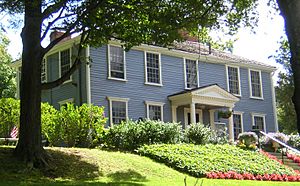Suffolk Resolves facts for kids
The Suffolk Resolves were important statements made by leaders in Suffolk County, Massachusetts, on September 9, 1774. These statements strongly disagreed with a new British law called the Massachusetts Government Act. This law took away many rights from the people of Massachusetts.
The Resolves also called for a boycott. This meant people would stop buying goods from Britain. They would continue this boycott until Britain canceled several unfair laws, known as the Intolerable Acts. A famous politician named Edmund Burke saw these Resolves as a big step toward the American colonies wanting independence. The First Continental Congress supported the Suffolk Resolves on September 17, 1774.
Contents
Why the Suffolk Resolves Were Important
In August 1774, leaders from several counties in Massachusetts met in Boston. They were part of groups called Committees of Correspondence. Their goal was to oppose the new Massachusetts Government Act. This act took away important rights from the people of Massachusetts.
The leaders urged all counties in Massachusetts to close their courts. This was a way to protest the unfair British law. Many counties followed this advice. By early October, most counties had closed their courts.
As each county closed its courts, it also released a statement. These statements explained why they were protesting. The Suffolk Resolves became the most famous for two main reasons. First, it was very well-written. Second, the Continental Congress officially supported it. Suffolk County, where Boston is located, was the only county where courts stayed open. This was because British soldiers protected them.
Creating the Resolves
On September 6, 1774, the Suffolk County Committee of Correspondence met. Joseph Warren presented the first draft of the Suffolk Resolves. Three days later, on September 9, they approved the final version. This happened at the Daniel Vose House in Milton, Massachusetts. At that time, Milton was part of Suffolk County.
The meeting where they adopted the Resolves first started in Dedham. The Suffolk Resolves, like other county statements, spoke out against the Intolerable Acts. These acts were unfair laws passed by the British Parliament.
The Suffolk Resolves specifically called for several actions:
- People should stop buying British goods. They should also limit what they sold to Britain.
- People should not obey the Massachusetts Government Act or the Boston Port Bill.
- Anyone appointed to a position under the Massachusetts Government Act should resign.
- People should refuse to pay taxes until the Massachusetts Government Act was canceled.
- Massachusetts should create its own government. This government would be free from the king's power. This would last until the Intolerable Acts were repealed.
- The colonies should form their own local armies, called militia.
Paul Revere's Ride and Congress's Support
Paul Revere, known for his famous ride, also delivered a copy of the Resolves. He took them to the First Continental Congress in Philadelphia, Pennsylvania. On September 17, the Congress officially supported the Resolves. This showed that the colonies stood together.
John Adams, a future president, wrote about that day in his diary. He said it was one of the happiest days of his life. He felt that America would support Massachusetts, no matter what.
Supporting the Suffolk Resolves changed things in the Congress. It helped lead to other big decisions. One was the Continental Association. This was an agreement for all colonies to stop importing British goods. Before this, such agreements were only in small areas. The Continental Association applied to all rebellious colonies. Groups like the Committees of Safety helped make sure people followed this agreement. They created a network similar to the Sons of Liberty.
Many other counties and colonies also made statements against Britain. But the Suffolk Resolves and other Massachusetts county statements were special. They were the first to call for widespread disobedience against British rule.
Remembering the Resolves
There is a historic plaque on Adams Street in Milton. It marks the original spot of the Daniel Vose House. This is where the Suffolk Resolves were signed.
In 1950, the house was moved to save it from being torn down. It is now at 1370 Canton Avenue in Milton. Today, it is known as the Suffolk Resolves House. It has been restored to look like it did during colonial times. It is now the main office for the Milton Historical Society. The house was added to the National Register of Historic Places in 1973. Visitors can go and see it.
See also
 In Spanish: Resolución de Suffolk para niños
In Spanish: Resolución de Suffolk para niños



